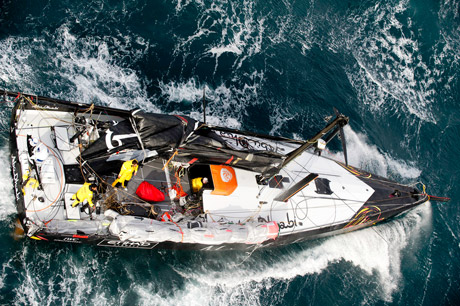
Abu Dhabi Ocean Racing's yacht Azzam, skippered by Britain's Ian Walker, returns to Alicante, Spain after the mast broke in rough weather on the first day of racing on leg 1 of the Volvo Ocean Race 2011-12. (Photo Credit: Paul Todd/Volvo Ocean Race)
. world board sport news : Fleet Battered By Elements In Brutal First 24 Hours - 06 November 2011 - 14:56
Volvo Ocean Race 2011 - 2012
SAILING VOR2012. Leg 1, Day 2. Alicante, Spain – Two of the six boats in the Volvo Ocean Race 2011-12 were forced to suspend racing inside the first 24 hours offshore as the teams were beset by brutal sea conditions while still in the Mediterranean.

Abu Dhabi Ocean Racing's yacht Azzam, skippered by Britain's Ian Walker, returns to Alicante, Spain after the mast broke in rough weather on the first day of racing on leg 1 of the Volvo Ocean Race 2011-12. (Photo Credit: Paul Todd/Volvo Ocean Race)
Abu Dhabi Ocean Racing came back into Alicante under engine this morning after the mast on the team’s racing yacht Azzam had broken in five-metre waves and 30 knots of wind the previous night, just six hours and 85 nautical miles from the start of Leg 1, a 6,500-nm haul to Cape Town.
While Ian Walker’s team were on their way back to the start port, rivals Team Sanya were reporting damage to their hull while sailing upwind in 35-38 knots.
The boat was approximately 30nm southeast of Motril, on the coast of Spain. The wind was blowing 43 knots and the waves were around 10.5 metres, the team reported. They suspended racing and made their way to the port of Motril to assess the damage.
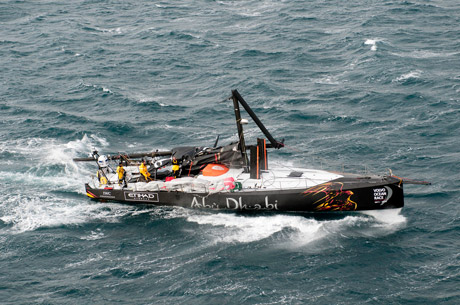
Abu Dhabi Ocean Racing's yacht Azzam, skippered by Britain's Ian Walker, returns to Alicante, Spain after the mast broke in rough weather on the first day of racing on leg 1 of the Volvo Ocean Race 2011-12. (Photo Credit: Paul Todd/Volvo Ocean Race)
In a graphic demonstration of the problems all the boats were facing, an interview filmed on board CAMPER with Roberto “Chuny” Bermúdez resulted in the Spaniard being blown to the ground and slammed across deck.
“The Mediterranean sometimes gets like this … but the boat is going fine,” the video shows him saying to camera, just as he is knocked off his feet. Unscathed, he continues the interview below deck.
Abu Dhabi had left Alicante at the top of the leaderboard having won the opening In-Port Race and they were challenging for the lead in Leg 1 when disaster struck at 1915 UTC on Saturday, around 30 miles southwest of Cartagena.
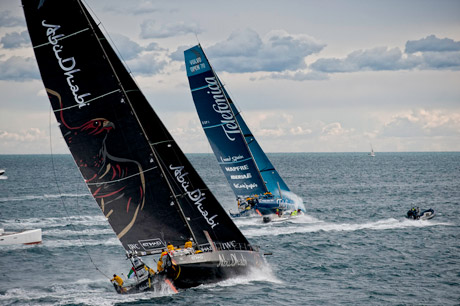
Abu Dhabi Ocean Racing, skippered by Ian Walker from the UK chasing Team Telefonica, skippered by Iker Martinez from Spain at the start of leg 1 of the Volvo Ocean race 2011-12 from Alicante, Spain to Cape Town, South Africa. (Photo Credit: Paul Todd/Volvo Ocean Race)
The crew recovered the rig and came back to Alicante before launching into a round-the-clock repair effort this morning. The replacement mast arrived in Alicante at around 1400 UTC.
“I think it is too early to start making judgments but certainly we believe we can [win the race],” said Walker, his voice full of emotion.
“We have put so much work into this project – everybody, and you just don’t… don’t want to let anyone down. When you have worked so hard every day for 18 months you are desperate to do well. We still are desperate to do well – the race isn’t lost.”
Describing the moments leading up to the loss of the mast, Walker said his “heart was in his mouth” as Azzam leapt off the back of a steep wave at around 12 knots before crashing back down.
“I was steering and we just came off a big wave,” he said. “I know it’s a big wave when my feet leave the ground. You always have your heart in your mouth when that happens. When we landed the mast just kept going. We immediately numbered off which is our safety drill to make sure we haven’t lost anyone over the side. Then we set about trying to retrieve whatever we could.”
Mike Sanderson, skipper of Team Sanya, the first sole Chinese entry in the race, also promised to bounce back from the setback in a message from the boat written while they were an hour away from port.
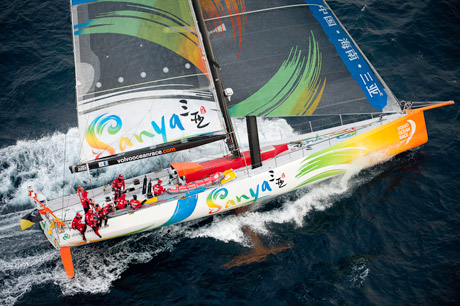
Team Sanya, skippered by Mike Sanderson from New Zealand at the start of leg 1 of the Volvo Ocean race 2011-12 from Alicante, Spain to Cape Town, South Africa. (Photo Credit: Paul Todd/Volvo Ocean Race)
“Right now we have no idea how major the damage is,” Sanderson said. “We are all safe though.
“The guys are doing a fantastic job, all very positive and working incredibly hard even though you can see the bitter disappointment on all there faces.
“Be under no illusion though, we will be back with vengeance.”
Sanderson and the team were still assessing the damage to Sanya, the only one of the six boats that is not brand new, in Motril on Sunday. It was not immediately clear what had caused the incident.
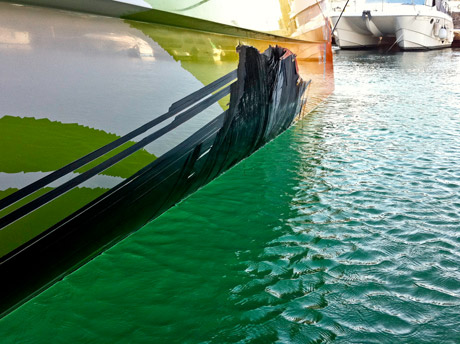
Team Sanya in the Mediterranean port of Motril assessing the state of their boat after hull damage forced them to suspend racing on Leg 1 of the Volvo Ocean Race 2011-12. (Photo Credit: Team Sanya/Volvo Ocean Race)
“We are fighters and our goal remains to take some scalps and get ourselves on the podium a couple of times and get in everyone’s way and see how many points we can earn,” said Sanderson. “We can do that – there’s no doubt about it.”
Those sentiments were echoed by Volvo Ocean Race CEO Knut Frostad, who competed in the race four times himself, twice as skipper.
“These are some of the toughest conditions boats can run into in the Volvo Ocean Race but the teams and their shore crews are fully prepared for these types of incidents and they will be working around the clock to get the boats back racing as soon as possible.”
On the racecourse, CAMPER with Emirates Team New Zealand led the fleet towards the Strait of Gibraltar, with Team Telefónica and PUMA Ocean Racing powered by BERG hard on her heels near the Spanish coast. Groupama sailing team were approaching the Strait via the African coast in what was a tight race.
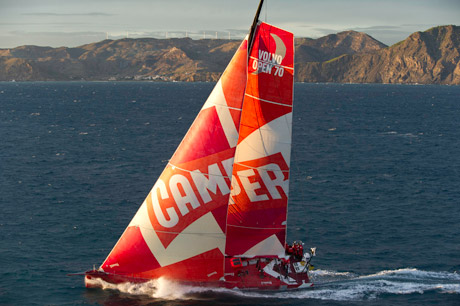
CAMPER with Emirates Team New Zealand, skippered by Chris Nicholson from Australia at the start of leg 1 of the Volvo Ocean race 2011-12 from Alicante, Spain to Cape Town, South Africa. (Photo Credit: Paul Todd/Volvo Ocean Race)
Teams are set to receive some relief from the battering, with the westerly winds and short, choppy sea state due to ease.
Chief meteorologist Gonzalo Infante said a high-pressure system west of Gibraltar would see winds drop to about 15 knots in the strait, and again to about 10 knots on the other side.
However, the teams will be pushing against two knots of tide through the natural bottleneck, which they are expected to reach at 2000 UTC.
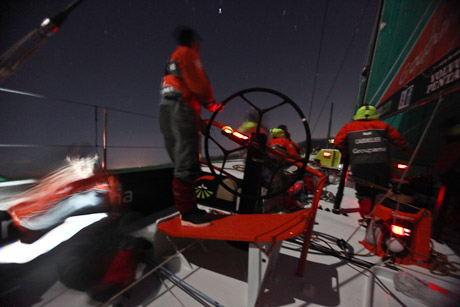
Groupama Sailing Team during leg 1 of the Volvo Ocean Race 2011-12, from Alicante, Spain to Cape Town, South Africa. (Photo Credit: Yann Riou/Groupama Sailing Team/Volvo Ocean Race)
Infante said the fleet may well split once entering the Atlantic, with some opting for the immediate boost of heavier air in the south, while others may hunt the benefit of a distant low in the west that won’t kick in for several hours.
“If we have a split of the fleet tomorrow, some in the south and some in the west, we will see the pay-off in 48 hours,’’ he said. “It looks like west is best, but this is still a bit risky.’’
Volvo Ocean Race 2011 - 2012
www.volvooceanrace.com
November 6, 2011 - 1600 UTC